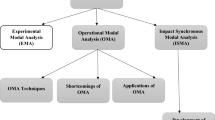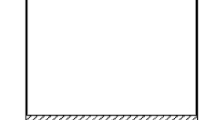Abstract
This study deals with operational modal identification techniques area, presenting a group of experimental and computational approaches about refining of modal characteristics for structural parts during their dynamic exploitation regime. Hereby, it can be included both into the modal experimental/operational analysis domain—with application in dynamic state evaluation in order to provide essential information to vibration control measures, and into the structural health monitoring area—providing a feasible tool for compiling the referenced state and estimating the failure imminence. The analyses were developed based on the laboratory setup, taking into account a simple structural element with constant mechanical and geometrical characteristics. The theoretical approaches contain both analytical evaluations, and computational simulations with the help of the finite element method. The results comparison between the classical modal identification techniques and the proposed method reveals an improved capability of the last for modal characterization of a singular structural element within its dynamic evolution, also taking into account that the number of experimental measurements was constantly maintained. Future developments will take into consideration the applicability of these assessments for structural ensembles or variable characteristic elements.
Access provided by CONRICYT-eBooks. Download conference paper PDF
Similar content being viewed by others
1 Introduction
Experimental identification of modal parameters has been developed during the last decades. Nowadays, the structural vibration testing and analysis provide a useful tool for many industries, including aerospace, auto-making, manufacturing, materials production, power generation, and many others. It is useful to reduce the effects of unwanted vibration because those can cause fatigue or degrade the performance of the structure. Vibration can be unavoidable or even desirable, hereby the goal may be to understand the effect on the structure, or to control or modify the vibration, or to isolate it from the structure and minimize structural response. Dynamic testing and continuous monitoring based on Operational Modal Analysis (or Output-only Modal Analysis—OMA) supply a very useful experimental tool, which allow periodic/continuous assessment of structures through the analysis of their response to ambient excitation, while they are in normal operation regime. For small structures tested in a controlled environment, inside a laboratory, it is available the Experimental Modal Analysis (EMA), which is a method based on the measurement of the structure response to one/several also measured dynamic forces. Combining EMA and OMA techniques recently has been explored and developed so called Operational Modal Analysis with eXogenous inputs (OMAX), which supposed an artificial force used in operational conditions. Major difference between OMAX and EMA derived from the operational forces that are included in the model of the analyzed system instead of being assumed as residual noise.
A new idea of EMA that only use the structural free vibration response due to initial conditions was presented by Wang and Cheng [1]. This idea can also be extended and applied to the general structure with non-proportional damping case and the proposed methodology can therefore enhance the structural modal analysis technique [1]. In the study [2], six aluminum beams of different configurations (with/without cuts of various lengths) were used for conducting experiments regarding impact test, shaker test, and operational modal analyses. Within the thesis [3] the uncertainty impacting OMA was grouped into four categories, in order to provide an insight into relative impacts of different uncertainty sources in OMA.
A novel procedure to perform OMA on a rotating cantilever beam is described in [4], using Digital Image Correlation to measure the deformation of the beam from images captured with a pair of high-speed digital cameras. Modal parameters are determined from the deformation data using Ibrahim Time Domain method. DaSilva and Pereira [5] discuss the effect of the presence of harmonic components in the process of identification of modal parameters, and use the concept of probability density function as a tool to separate the operational modes (harmonic) from the structural ones. Practical problems to be dealt with when planning an ambient vibration based system identification test on a structure are discussed by Cantieni in [6].
In the paper [7], the comparison between two different vibration testing techniques is presented. The first approach takes advantage of the frequency domain decomposition, of the response cross power spectral densities (CPSD) to estimate both the natural frequencies and the “unsealed” mode shapes, whereas the second one, starting from the Hilbert Transform of auto power spectral densities and taking account of the CPSD, allows one to get the frequency response functions [7]. Ulriksen et al. [8] demonstrates an application of a proposed modal and wavelet analysis-based damage identification method to a wind turbine blade. OMA was conducted to obtain mode shapes for undamaged and damaged states of the blade.
This work is a part of a large study regarding simplified EMA and OMA procedures available for modal identification of various structural elements. The authors present some experimental assessments dealing with the improvement of the modal information database based on acquiring and processing additional dynamics of explored structural element.
2 Experimental Basics
A general view of the experimental setup was depicted in Fig. 38.1, where the first picture (a) presents a snapshot during the experimental tests and the last picture (b) shows a detail of the accelerometer montage on the explored structural element. For laboratory tests was assumed a cantilever montage based on a constant section beam element with 15 mm width, 2 mm thickness and 1000 mm length, of aluminum alloy, with 68,900 MPa Young’s Modulus, 0.33 Poisson’s Ratio and 2710 kgm3 mass density. Modal identification procedure was performed based on transversal dynamics of the beam, and comparison with the analytic and finite element method results was done. Rolling hammer technique was used, with five inputs sequence.
Diagrams in Fig. 38.2 present magnitudes of frequency response function evaluated for acquired acceleration of transversal beam direction (y axis—see Fig. 38.1a). It have to be mentioned that EMA method was used in order to provide a validation tool for measuring points through the coherences signals between each input and the output. Goodness of modal identification procedure results from the correlation of the peaks marked on diagrams within Fig. 38.2.
During the analysis it was observed that the finite element analysis provides additional frequency information and modes besides those specifically for the basic transversal bending motion. Two examples were depicted in Fig. 38.3, where picture (a) denotes the torsional and picture (b) denotes lateral bending shapes.
Taking into account that many of health monitoring methods require evaluations of changes within modal frequencies, and the vibration control techniques based on the resonances shifting, the authors had been proposed to experimentally evaluate the most of the spectral information related to dynamics of the analyzed element, maintaining, if it is possible, the same volume of experimental tests.
3 Additional Experimental Research
According with previously mentioned goal, it was used a six degree-of-freedom (6DoF) transducer in order to explore the entire range of analyzed element motions. Picture in Fig. 38.4 depicts a detailed view of glued montage of 6DoF MPU-6050 transducer onto the beam in respect with motion directions—z axis respects the orthogonal rule related on transducer plane. Magnitudes of frequency response functions for the three accelerations and three gyrations, provided by the 6DoF transducer, were depicted in Fig. 38.5. Red dots denote the peaks over the thresholds. The correlation between the frequency values related with these peaks, for all six signals, can be evaluated within the chart in Fig. 38.6, where star symbols was used for main direction of beam vibratory motion (transversal bending).
One concluding remark resulted from this chart analysis indicates that most of the significant frequencies can be discovered within the acceleration signals, thus that acquire of the only triaxial acceleration signals can provide a larger range of modal information than the classical method. Supposing previous observation and returning to the initial experimental setup (see Fig. 38.1), it was considered and analyzed entirely the three acceleration signals. The results was presented in Fig. 38.7, where both the chart of modal frequencies, and the magnitude plots reveal the additional significant information contained within acceleration onto x and z axes. Similar to diagram in Fig. 38.6, the star symbols denote main vibratory motion in respect with the transversal direction.
4 Concluding Remarks
The observations related to the experimental tests performed by the authors and partially presented within this paper lead to the conclusion that using the triaxial accelerometers for exploring the vibratory motion of a structural element provides an improved tool to enlarge the spectral information database and offers a simplest way to refine the modal identification analyses.
References
B.-T. Wang, D.-K. Cheng, Modal analysis of mdof system by using free vibration response data only. J. Sound Vib. (2007). doi:10.1016/j.jsv.2007.09.030
S. Rudroju, A. Gupta, S. Yandamuri, Operational modal analysis of aluminum beams. J. IEST 50(1), 74–85 (2007)
S.K. Ciloglu, The impact of uncertainty in operational modal analysis for structural identification of constructed systems. A Thesis Submitted to the Drexel University in Partial Fulfillment of the Requirements for the Degree of Ph.D., Aug 2006
S.S. Rizo-Patron, J. Sirohi, in Operational modal analysis of a rotating cantilever beam using high-speed digital image correlation. 57th AIAA/ASCE/AHS/ASC Structures, Structural Dynamics, and Materials Conference, AIAA SciTech Forum, (AIAA 2016–1957). http://dx.doi.org/10.2514/6.2016-1957
B.E.P. da Silva, J.A. Pereira, Effect of harmonic components in an only output based modal analysis, in Proceedings of COBEM 2009—20th International Congress of Mechanical Engineering, Gramado, RS, Brazil 15–20 Nov 2009
R. Cantieni, Application of ambient vibration testing (operational modal analysis) in practice, http://rcidynamics.ch/site/downloads/
A. Agneni, R. Brincker, B. Coppotelli, (2004). On modal parameter estimates from ambient vibration tests, in Proceedings of the International Conference on Noise and Vibration Engineering: ISMA2004 Leuven, Belgium, 20–22 Sept 2004
M.D. Ulriksen, D. Tcherniak, P.H. Kirkegaard, L.Damkilde, Operational modal analysis and wavelet transformation for damage identification in wind turbine blades. Struct. Health Monit. 15(4), 381–388 (2015). doi:10.1177/1475921715586623
Author information
Authors and Affiliations
Corresponding author
Editor information
Editors and Affiliations
Rights and permissions
Copyright information
© 2018 Springer International Publishing AG
About this paper
Cite this paper
Nastac, S., Debeleac, C. (2018). Assessments on Operational Modal Identification Refining of a Structural Element. In: Herisanu, N., Marinca, V. (eds) Acoustics and Vibration of Mechanical Structures—AVMS-2017. Springer Proceedings in Physics, vol 198. Springer, Cham. https://doi.org/10.1007/978-3-319-69823-6_38
Download citation
DOI: https://doi.org/10.1007/978-3-319-69823-6_38
Published:
Publisher Name: Springer, Cham
Print ISBN: 978-3-319-69822-9
Online ISBN: 978-3-319-69823-6
eBook Packages: Physics and AstronomyPhysics and Astronomy (R0)











